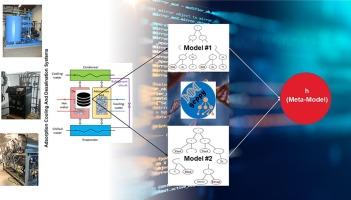用基因表达编程法建立流化吸附床床壁传热系数模型
IF 4.5
2区 工程技术
Q2 ENGINEERING, CHEMICAL
引用次数: 0
摘要
使用吸附式冷却器(AC)的吸附冷却和脱盐方法在能源技术中大有可为。然而,传统填料床吸附式冷却器的性能系数低、体积大,这主要是由于吸附剂床的空隙率高,导致传热系数低,从而带来了巨大的挑战。为了应对这一挑战,我们提出了一种新方法:用流化吸附床代替传统的填料床。我们还引入了基因表达编程(GEP)作为一种创新的人工智能(AI)方法,用于对吸附床的床壁传热系数进行建模。我们的研究包括为低压吸附过程设计的传热吸附床反应器的计算和模型验证。吸附床的流化剂是蒸发器中产生的水蒸气。测试中使用硅胶作为母吸附材料。通过实验成功验证和确定了传热系数,并使用制定的(b-t-wHTc)元模型进行了估算。模型评估的数据与实验结果非常吻合。我们的计算结果表明,基于 GEP 的模型能够准确预测传热系数,适用于分析流化吸附床反应器。概述的研究可作为后续强化传热吸附床反应器模拟的基准,因为这些研究是波兰国家科学中心支持的编号为 2018/29/B/ST8/00442 的项目的组成部分,该项目题为 "吸附床改良结构中吸附过程强化方法的研究"。本文章由计算机程序翻译,如有差异,请以英文原文为准。

Modeling of bed-to-wall heat transfer coefficient in fluidized adsorption bed by gene expression programming approach
Adsorption cooling and desalination methods with adsorption chillers (AC) are promising in energy technologies. However, the low-performance coefficient and bulkiness of traditional packed-bed ACs, primarily due to the high voidage of the sorbent beds leading to low heat transfer coefficients, pose significant challenges. Despite numerous attempts, a practical solution to this problem is yet to be found.
In response to this challenge, we propose a novel approach: a fluidized adsorbent bed instead of the traditional packed bed. We also introduce gene expression programming (GEP) as an innovative artificial intelligence (AI) method for modeling the bed-to-wall heat transfer coefficient in the adsorption bed. Our study includes calculations and model validation for a heat transfer adsorption bed reactor designed for low-pressure adsorption processes. The fluidizing agent of the adsorbent bed was water vapor generated in the evaporator. Silica gel was used as the parent adsorption material in our tests. The heat transfer coefficient was successfully validated and determined through experiments and estimated using the formulated (b-t-wHTc) meta-model. The data evaluated by the model aligns well with the experimental results. Our calculations demonstrate that the GEP-based model accurately predicts the heat transfer coefficient and is suitable for analyzing the fluidized adsorption bed reactor.
The outlined studies serve as a benchmark for subsequent simulations of the intensified heat transfer adsorption bed reactor, as they are integral to project No. 2018/29/B/ST8/00442, titled “Research on sorption process intensification methods in modified construction of adsorbent beds,” supported by the National Science Center in Poland.
求助全文
通过发布文献求助,成功后即可免费获取论文全文。
去求助
来源期刊

Powder Technology
工程技术-工程:化工
CiteScore
9.90
自引率
15.40%
发文量
1047
审稿时长
46 days
期刊介绍:
Powder Technology is an International Journal on the Science and Technology of Wet and Dry Particulate Systems. Powder Technology publishes papers on all aspects of the formation of particles and their characterisation and on the study of systems containing particulate solids. No limitation is imposed on the size of the particles, which may range from nanometre scale, as in pigments or aerosols, to that of mined or quarried materials. The following list of topics is not intended to be comprehensive, but rather to indicate typical subjects which fall within the scope of the journal's interests:
Formation and synthesis of particles by precipitation and other methods.
Modification of particles by agglomeration, coating, comminution and attrition.
Characterisation of the size, shape, surface area, pore structure and strength of particles and agglomerates (including the origins and effects of inter particle forces).
Packing, failure, flow and permeability of assemblies of particles.
Particle-particle interactions and suspension rheology.
Handling and processing operations such as slurry flow, fluidization, pneumatic conveying.
Interactions between particles and their environment, including delivery of particulate products to the body.
Applications of particle technology in production of pharmaceuticals, chemicals, foods, pigments, structural, and functional materials and in environmental and energy related matters.
For materials-oriented contributions we are looking for articles revealing the effect of particle/powder characteristics (size, morphology and composition, in that order) on material performance or functionality and, ideally, comparison to any industrial standard.
 求助内容:
求助内容: 应助结果提醒方式:
应助结果提醒方式:


